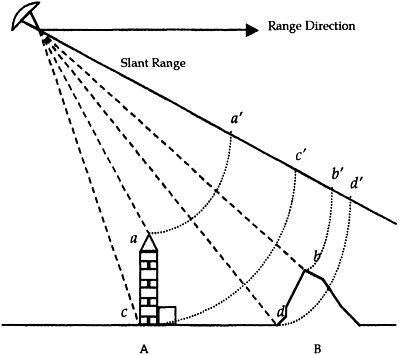213.
| [Cover] [Contents] [Index] |
Page 29
time needed to travel to the bottom of the same object. Figure 1.15 shows two targets (a building and a mountain) that are illuminated by a radar sensor. The microwave energy transmitted by the radar will reach the tops of both objects (points a and b in Figure 1.15) before the bottoms (points c and d). The antenna will first receive the reflected energy from a and b then, some time later, the energy reflected from c and d. After projection on to the slant range domain, the result is called the layover effect.
It might be inferred from the preceding discussion that the higher the isolated target the greater the layover effect. However, layover is also controlled by another important factor: the angle, θf, between the front of the target and energy path (Figure 1.16). Layover will occur only if θf exceeds 90° (see object A in Figure 1.16). If θf is smaller than 90°, as in the case of object B in Figure 1.16, then microwave energy will first illuminate the bottom, then the top of the object, and there will be no layover effect.
‘Foreshortening’, like layover, results from the fact that radar is a sidelooking sensor. The object labelled B in Figure 1.16 is symmetrical in cross-section, but the angle between its front slope ab and the microwave radiation emitted by the instrument is less than 90°. Hence, the front slope distance ab appears to be less than the back slope distance bc when projected on to slant range. Since the front slope also tends to reflect microwave energy more strongly than does the back slope, it will appear to be

Figure 1.15 The layover effect in radar remote sensing.
| [Cover] [Contents] [Index] |
EAN: 2147483647
Pages: 354
- ERP Systems Impact on Organizations
- Challenging the Unpredictable: Changeable Order Management Systems
- ERP System Acquisition: A Process Model and Results From an Austrian Survey
- The Second Wave ERP Market: An Australian Viewpoint
- Enterprise Application Integration: New Solutions for a Solved Problem or a Challenging Research Field?